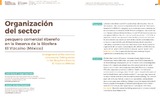| dc.rights.license | http://creativecommons.org/licenses/by-nc-sa/3.0/ve/ | |
| dc.contributor.author | Crespo Guerrero, José Manuel | |
| dc.contributor.author | Jiménez Pelcastre, Araceli | |
| dc.date.accessioned | 2016-12-06T16:55:57Z | |
| dc.date.available | 2016-12-06T16:55:57Z | |
| dc.date.issued | 2016-12 | |
| dc.identifier.uri | http://www.saber.ula.ve/handle/123456789/42729 | |
| dc.description.abstract | La Reserva de la Biosfera de El Vizcaíno en Baja California Sur (México)
fue creada en 1988. Durante los siguientes años, el Comité del Patrimonio
Mundial de la UNESCO le otorgaría, en dos ocasiones, reconocimientos por
su valor natural y cultural. Sus 2.546.790 ha la configuran como una de las
reservas más extensas del mundo. Representa el 10 % de las áreas naturales
protegidas de México. Además, es de tipo marítimo-terrestre, el 12 % de su
superficie se localiza en aguas del océano Pacífico y el golfo de California.
No es de extrañar que una de sus actividades económicas fundamentales
sea la pesca comercial ribereña. Mediante información de naturaleza
cualitativa y cuantitativa, el presente artículo tiene por objeto mostrar la
organización de las cuatro zonas pesqueras de la Reserva: Golfo, Esteros y
laguna de San Ignacio, Pacífico Norte y Complejo lagunar Ojo de Liebre. | es_VE |
| dc.language.iso | es | es_VE |
| dc.publisher | SABER-ULA | es_VE |
| dc.rights | info:eu-repo/semantics/openAccess | |
| dc.subject | Pesca comercial ribereña | es_VE |
| dc.subject | Área natural protegida | es_VE |
| dc.subject | Baja California Sur | es_VE |
| dc.title | Organización del sector pesquero comercial ribereño en la Reserva de la Biosfera El Vizcaíno (México) | es_VE |
| dc.title.alternative | Arrangement of the riverside commercial fishing sector in the Biosphere Reserve El Vizcaíno (México) | es_VE |
| dc.type | info:eu-repo/semantics/article | |
| dc.description.abstract1 | The Biosphere reserve El Vizcaino in Southern Lower California State
(Mexico) dates back to 1988. After some years, the UNESCO Committee for
the World Heritage would grant it, in two occasions, some acknowledgement
because of its natural and cultural value. It is considered to be one of the
largest reserves in the entire world, due to its 2,546,790 hectares. It means
10% of the natural preserved areas in Mexico. Besides, it is both of the
maritime and terrestrial type, since 12% of its area is located in the waters of
both the Pacific Ocean and the California Gulf. It is not surprising that one of
its main economic activities is the riverside commercial fishing. This research
paper will shed some light, by means of some quantitative and qualitative
data, on the organization of the four fishing areas of the reserve: Golfo (Gulf),
Esteros y laguna de San Ignacio (Tideland and San Ignacio Pool), Pacífico
Norte (Northern Pacific) and Laguna Ojo de Liebre (Ojo de Liebre Pool). | es_VE |
| dc.description.colacion | 236 - 259 | es_VE |
| dc.description.email | jcrespo@igg.unam.mx | es_VE |
| dc.description.email | aracelijip@hotmail.com | es_VE |
| dc.description.frecuencia | Semestral | |
| dc.identifier.edepositolegal | ppi 2012ME4104 | |
| dc.identifier.eissn | 2244-8853 | |
| dc.publisher.pais | Venezuela | es_VE |
| dc.subject.facultad | Facultad de Ciencias Forestales y Ambientales | es_VE |
| dc.subject.institutoinvestigacion | Instituto de Geografía y Conservación de los Recursos Naturales (IGCRN) | |
| dc.subject.keywords | Riverside commercial fishing | es_VE |
| dc.subject.keywords | Natural preserved area | es_VE |
| dc.subject.keywords | Economic organization | es_VE |
| dc.subject.keywords | Baja California Sur | es_VE |
| dc.subject.seccion | Revista Geográfica Venezolana: Artículos | es_VE |
| dc.subject.thematiccategory | Geografía | es_VE |
| dc.subject.tipo | Revistas | es_VE |
| dc.type.media | Texto | es_VE |


